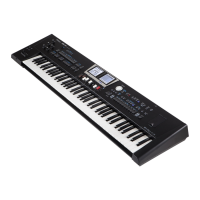Using Rhythms
37
Function
[SYNC START]
indicator
Explanation
Sync Start Lights red
Rhythm playback can be started by playing a
note or chord. Press [START/STOP]/[ */, ] to stop
rhythm playback.
Sync Start/Stop Lights green
Rhythm playback can be started by playing
a note or chord. Playback will stop when you
release all keys.
— Dark
Rhythm playback needs to be started and
stopped using the [START/STOP]/[ */, ]button
(or the assigned optional pedal switch or
D-Beam control).
VARIATION [1], [2], [3], [4]
These buttons are used to select the complexity (number of parts)
of the rhythm arrangement:
[VARIATION] Explanation
[1]
The simplest accompaniment pattern. A good choice for
the rst verse of the songs you play.
[2]
A slightly more complex pattern you may want to use for
subsequent verses.
[3] This pattern would be a good choice for the rst chorus
[4]
This is the most complex arrangement. Consider selecting
it for the bridge or the nal chorus sections of a song.
MEMO
The VARIATION patterns are repeated (played back in a loop)
until a dierent pattern is selected or rhythm playback is
stopped.
[INTRO] / [ ' ]
Selects an introduction, which is usually used at the beginning of
a song. You can, however, also select this pattern for other song
sections. The behavior of the Intro pattern depends on when you
press the [INTRO] button:
[INTRO] Explanation
Pressed before
starting rhythm
playback
The indicator lights.
When you start rhythm playback, the BK-9 rst plays a
musical introduction. (This pattern is played back only
once).
Pressed
during rhythm
playback
The indicator ashes to signal that the INTRO pattern will
begin on the next downbeat.
When the intro is nished, the BK-9 returns to the
previously selected VARIATION pattern.
There are, in fact, four dierent INTRO patterns, that can be
selected using the VARIATION [1], [2], [3] and [4] buttons. Again,
the VARIATION buttons determine the complexity of the intro
arrangement.
[ENDING] / [ & ]
This button allows you to end your songs with a suitable closing
section if you don’t want to simply stop playback. The behavior
of the Ending pattern depends on when you press the [ENDING]
button:
[ENDING] Explanation
Pressed before
starting rhythm
playback
The indicator lights. When you start rhythm playback,
the BK-9 plays a musical ending. At the end of the
phrase, playback stops.
Pressed during
rhythm playback
The indicator ashes to signal that the ENDING
pattern will begin on the next downbeat.
When the ending is nished, rhythm playback stops.
Press the button
twice in succession
(“doubleclick”).
The Ritardando function is applied to Ending pattern.
There are four dierent ENDING patterns, that can be selected using
the VARIATION [1], [2], [3] and [4] buttons.
Again, the VARIATION buttons determine the complexity of the arrangement.
[BASS INV]
This button is used to switch the “Bass Inversion” function on or
o. While the button is dark, the rhythm bass part always plays the
fundamental of your notes or chords. Example: if you play a chord
consisting of the notes C, E and G (which is recognized as a C major
chord), the bass part plays a C.
If the [BASS INV] button lights, the rhythm bass part uses the lowest
notes of the chords you play.
Example: if you play a chord consisting of the notes E, G and C (still
a C major chord), the bass part plays an E. This function therefore
gives you more artistic licence.

